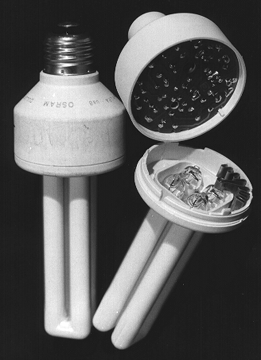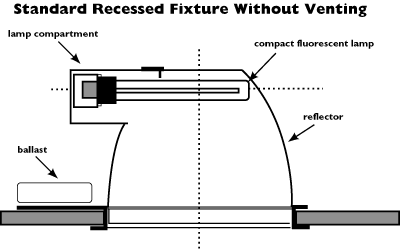

The base-up alternative produces almost 100% of the rated light output. The light output from the base-down CFL decreases by almost 25% after a few minutes of operation. However, by adding a thermal bridge (see opposite photos), the performance of the base-down CFL improves dramatically.
Heat generated in fluorescent luminaires can result in 15% to 20% less light output and reduced efficacy. To overcome the problem, manufacturers are adopting design solutions developed by LBL researchers.
The actual light output and energy use of regular and compact fluorescent lighting systems can be significantly different from labeled (optimal) values. The key is temperature.
The notion of thermal efficiency has long been understood, but it's often neglected in luminaire design. Temperatures inside fluorescent fixtures are important because excess mercury condenses at the coldest point on a lamp, regulating light output and (for long fluorescent lamps) power consumption. Suboptimal temperatures lead to losses in light output. Lamp temperature depends on lamp and fixture geometry, wattage, ballasting, ambient temperature, lamp orientation, and air circulation.
A frequent criticism of compact fluorescent lamps (CFLs) "not enough light" can be traced partly to overheating. This arises because of lamp orientation or because CFLs are used in fixtures designed for incandescent lamps, where temperature does not affect light output. Other unwanted side effects may include color shifts toward blue-green, reduced color rendering, and shortened system life.

Compact fluorescent lamp
Because power consumption decreases as temperature increases in long-tube fluorescent systems, thermal factors make it hard to design and calculate energy savings from changes in these lamps. A pre-retrofit system may operate far from the optimal temperature, while the post-retrofit system may run at or near the optimum. Reasons for this include fewer or lower- wattage lamps and ballasts in the post-retrofit fixture and better ventilation characteristics. CFLs do not exhibit the same reduction in power as do long fluorescents and, as a result, efficacy (lumens/watt) diminishes dramatically as temperature increases.
A variety of clever strategies have been devised to optimize the thermal performance of fluorescent lighting systems. These include modifying lamps (conductive cooling) and fixtures (convective cooling). Another approach is to use mercury amalgams. They have not been widely adopted by lamp manufacturers because they can complicate the manufacturing process and be more costly than thermal management strategies.
 |
 |
A rippled copper strip attached to the glass tubulation in a CFL rapidly conducts heat away from the lamp.
For long-tube fluorescent systems, one of the technologies developed by Center researchers is a "spot cooler" that can be inserted so that it rests lightly against the top of the lamp (or beneath the lamp in an indirect pendant fixture). When applied to F40 lamps in enclosed wraparound fixtures, this strategy increases in light output by 15% and efficacy by 8%. A number of manufacturers are now planning to integrate spot coolers with their luminaires.
Thermal factors are also responsible for the fact that CFLs operating in a base-down position produce 15% to 20% less light (with a comparable reduction in lumens/watt) than when used in a base-up position. This is because excess mercury drips from the cold spot at the top of the lamp into the hot glass tubulation in the base, where it is revaporized. Work at LBL shows that a small copper strip fitted around the tubulation rapidly conducts heat away from the lamp, achieving up to 99% of rated light output (see photo and graph).
Another approach to thermal management is to increase air movement around the lamps. One solution is fan-based systems, but these are relatively costly, use extra energy, and require maintenance. A simpler strategy is to modify fixtures so that they are passively cooled. Researchers at LBL increased the light output of prototype recessed CFL downlights by adding up to 20% simply by adding ventilation slots. Proper slot size and positioning are critical because excessively large openings result in optical losses that offset part of the benefits related to lower temperatures. The optimized, vented fixtures have only 1% to 2% optical losses and are manufactured by Delray, Edison Price, Indy Lighting, Lightolier, Lithonia, Microflect, Prescolite, Reggiani, Staff, and Zumtobel.


Standard recessed fixture (top) and modifications (passive ventilation slots and tilted lamp) to achieve optimal thermal performance.
The most effective solution yet identified requires tilting the lamp downward by 5 to 10 degrees C. This places the tip in a cooler part of the fixture, allowing the mercury to settle to the tip more easily and improving the air flow.
One concern about convective ventilation is the potential for increased dirt buildup on the lamp and fixture, leading to reduced light output over time. In experiments conducted at LBL, dust was injected into a controlled chamber containing vented and unvented fixtures. Candlepower readings taken one meter below the fixtures revealed that vented fixtures had consistently less lumen depreciation over time than unvented ones. This may be because dust leaves the ventilated fixture before it has a chance to settle.
The measures described here are expected to add very little, if anything, to the production cost of lamps or fixtures. Convective venting adds virtually nothing to the cost of CFL downlights; conductive cooling in the lamp base costs about 10¢ per lamp; and spot coolers add about $5 per fixture. The resulting cost-performance tradeoff is increasingly viewed by lamp and luminaire manufacturers as an attractive opportunity for increasing the competitiveness of their products in markets where achieving higher lumen output is the name of the game.
--Evan Mills
Adapted from a version published in the IAEEL Newsletter, no. 2/93.
![]()
Michael Siminovitch
(510) 486-5863; (510) 486-6940 fax
or Chin Zhang
Lighting Research Group
Building Technologies Program